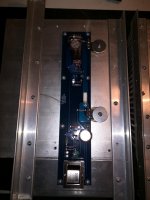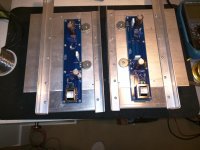What sort of powersupply are you using?
That is what VA rating on transformer and how much capacitance in power supply?
Same in both builds. It's a standard CRC (30mF-0R12-30mF) (each rail). the transformer is a 300VA R-core, 2x18v and 2 standard 35A Vishay recrifiers used.
One very quick thing you can do.
Run the amp in parallel mono.
Report back.
Made a RCA-female-chassis connector to two RCA-male cables and paralleled the outputs. I'm not used to listen to only one speaker but it seem to improve the bottom end quantity somewhat.
Maybe i could just add another pair of outputs and keep the same voltage supply levels and up the bias, i think the chassis heatsinks could take at least 70% more bias but the 300VA transformer cannot.
I guess it's a question of output impedance/drive ability rather then just "watts".
These speakers are 3 way, 4 speaker elements after all with the complex impedance of the x-over and the reactance that comes with it. 😡
Any more ideas?
EDIT: The single channel sounds thinner and more shouty with more forward treble/upper mid
The dual/paralleled setup is more relaxed, darker with a more laid back treble/upper mid
I wonder it that is due to the paralleled amplifiers them self or that the PSU only have one speaker thus only have to deal with half the impedance load.
Last edited:
Independent capacitor banks for each channel coming off main bank will also help.
I turboed Nelson's idea.
Also a bigger VA transformer also helps.
If you can afford a second 300VA transformer for dual mono that would also help.
I turboed Nelson's idea.
Also a bigger VA transformer also helps.
If you can afford a second 300VA transformer for dual mono that would also help.
Last edited:
One more thing you can do.
Reduce source resistors on Toshiba mosfets.
You could probably use 0.2 Ohms
Reduce source resistors on Toshiba mosfets.
You could probably use 0.2 Ohms
try amp on some other speakers before making final judgement
Don't really have any other high end speakers.
Got a pair Von Schweikert VR-2 but i know they are even harder to drive properly then the Focals are.
I have tried a small pair of sony bookshelf speakers from one of those compact "all-in-one" stereo, but they really cheap and doesn't put out any bass anyway. But they did sound OK when i tested the F5 with them 😛
By the way, will the circuit i drawn in post #1459 work at all? Or maybe some cascode instead if possible?
Anyone have experience with F6 + b&w cm5 ? How does it sound ? F6 is a good choice for the speakers ?
Sent from my Nexus 7 using Tapatalk
Sent from my Nexus 7 using Tapatalk
I have a question I hope is not too dumb. In the F6 I understand the 1000uF cap feeds back some of the output signal. Why is a non polar cap not used? I noticed in the 6moons article a pic of the amp shows 4 caps instead of the 2 on the diy boards. Would this be because the 6 moons amp has the caps back to back to make up 2 non polar caps?
these are not feedback caps
read article and thread , if you want to understand operation of circuit
read article and thread , if you want to understand operation of circuit
In the F6 I understand the 1000uF cap feeds back some of the output signal.
This capacitor connects the input (the transformer secondary) directly between the gate and source.
To allow the DC gate bias voltage to be applied (through the 10k), this blocking capacitor is needed.
Last edited:
Anyone interested I am selling my assembled boards here http://www.diyaudio.com/forums/swap-meet/281737-fs-two-f6-boards-components-capacitor-bank.html
Thanks,
Radu
Thanks,
Radu
I have a question I hope is not too dumb. In the F6 I understand the 1000uF cap feeds back some of the output signal. Why is a non polar cap not used? I noticed in the 6moons article a pic of the amp shows 4 caps instead of the 2 on the diy boards. Would this be because the 6 moons amp has the caps back to back to make up 2 non polar caps?
There is an AC voltage through the cap, but also a polarising voltage across it, to the order of 4.5V. In such a case the difference between polar and non-polar will be minor. However if you wish, I guess it could be used.
Does one need to change anything in the circuit if one experiments with transformers other than the Jensen? I ask because the transformer primaries have slightly different resistances - some more than the Jensen and some less.
Ok, I'll give it a shot once everything is collected. I was just worried that perhaps the 18-ohm R4 was chosen to have some relationship with the parallel primaries of the transformer.
Help
I thought I ran into some sort of problems. The PSU gives me good numbers and both sit at +24.74/-24.75 unload. I fired up one channel at a time and first on test was the channel on my right. I have the power turn on and checked closely on two meters. I didn't find any reading on bias, but instead the voltage at offset raised like crazy. I turned it off and back on again after serious checked. The LED was not on and again the reading at offset went over 2v but the bias had nothing. I turned off and disconnected all power so to recheck and found the LED was placed in wrong end. I took it for granted that it should be + to supply and - to ground. I turned the negative to the supply and + to ground and the LED back on.
I tried my luck to fired up the left channel by setting both trimmers in the middle and it fluctuated a bit but I could see readings on both meters. I then trimmed the offset close to 0 and let it sat at .5v for about 30 minutes. It was stable, the voltage without going anywhere.
I replaced both IRFP240s on the channel with problem and fired up after that. LED was on but offset voltage reminded the same, kept climbing and no reading on bias. What I have done wrong?? What else I should do to make it works ???
Thanks in advance
Albert
I thought I ran into some sort of problems. The PSU gives me good numbers and both sit at +24.74/-24.75 unload. I fired up one channel at a time and first on test was the channel on my right. I have the power turn on and checked closely on two meters. I didn't find any reading on bias, but instead the voltage at offset raised like crazy. I turned it off and back on again after serious checked. The LED was not on and again the reading at offset went over 2v but the bias had nothing. I turned off and disconnected all power so to recheck and found the LED was placed in wrong end. I took it for granted that it should be + to supply and - to ground. I turned the negative to the supply and + to ground and the LED back on.
I tried my luck to fired up the left channel by setting both trimmers in the middle and it fluctuated a bit but I could see readings on both meters. I then trimmed the offset close to 0 and let it sat at .5v for about 30 minutes. It was stable, the voltage without going anywhere.
I replaced both IRFP240s on the channel with problem and fired up after that. LED was on but offset voltage reminded the same, kept climbing and no reading on bias. What I have done wrong?? What else I should do to make it works ???
Thanks in advance
Albert
- Home
- Amplifiers
- Pass Labs
- The diyAudio Firstwatt F6

